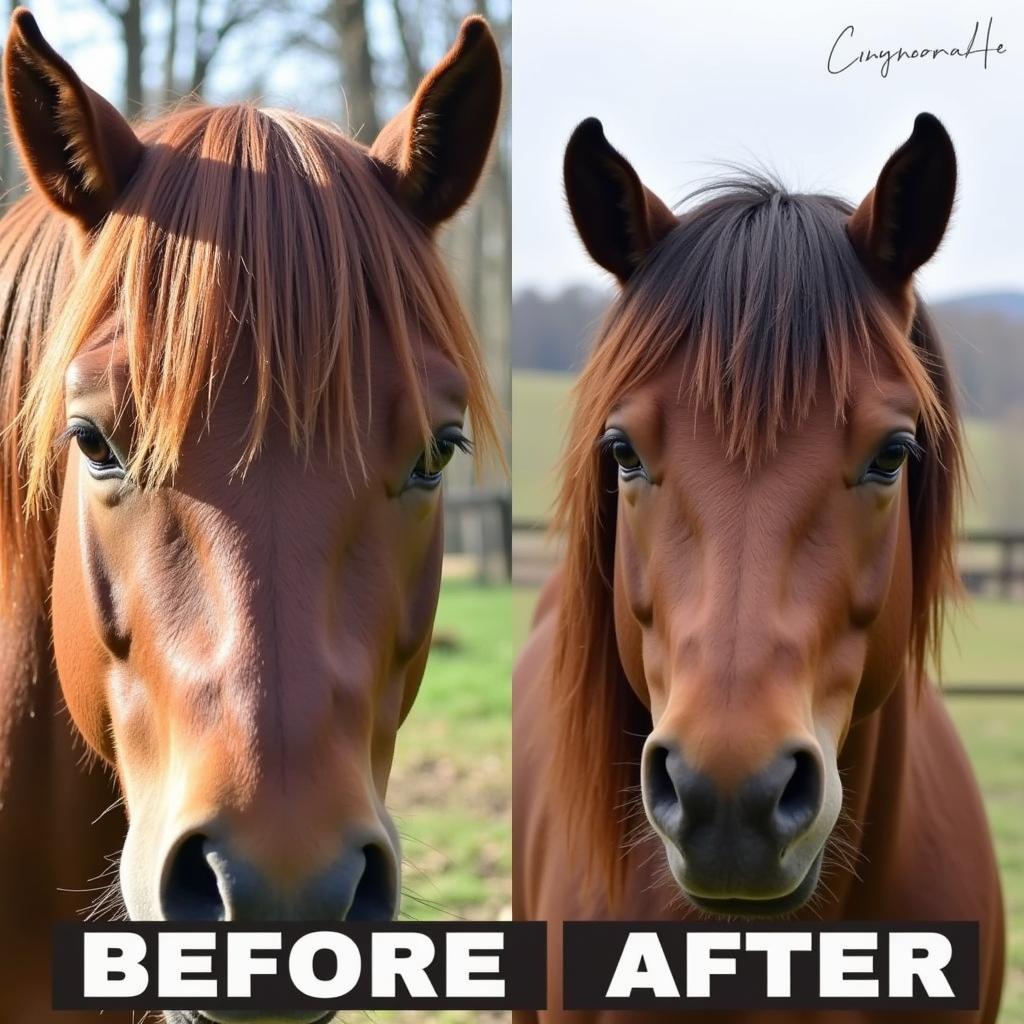Horse Mane Banding is a popular technique used to shorten and neaten a horse’s mane without the need for pulling. It creates a tidy and polished look, perfect for showing or simply enhancing your horse’s overall appearance. This comprehensive guide will delve into everything you need to know about horse mane banding, from the basics to advanced techniques.
 Before and after horse mane banding: Showing a long, unruly mane transformed into a neat, banded mane.
Before and after horse mane banding: Showing a long, unruly mane transformed into a neat, banded mane.
What is Horse Mane Banding and Why Do It?
Horse mane banding involves using small rubber bands to section and shorten the mane, giving it a pulled look without the discomfort often associated with traditional mane pulling. It’s a gentler alternative, ideal for sensitive horses or those new to mane management. Why choose banding? It offers a more natural look compared to braiding and allows for more even growth, preventing the mane from looking too thin or patchy. Banding can also make it easier to manage a thick, unruly mane, making grooming and braiding for competitions a much simpler process.
A Step-by-Step Guide to Banding Horse Mane
Here’s a detailed guide to help you master the art of horse mane banding:
- Gather your supplies: You’ll need small rubber bands (the type used for human hair braiding works well), a mane comb, and scissors.
- Prepare the mane: Comb the mane thoroughly to remove any tangles or knots. A damp mane is often easier to work with, as it reduces static and makes the hair more pliable.
- Section the mane: Divide the mane into small sections, about an inch wide. The size of the sections will determine the final length of the mane.
- Banding the sections: Place a rubber band around the base of each section, close to the crest. Wrap the band tightly, but not so tight that it causes discomfort to your horse.
- Shorten the mane: Using scissors, carefully trim the mane below each rubber band. Leave a small amount of hair extending below the band to create a neat, pulled look.
- Finishing touches: Once all sections are banded and trimmed, step back and assess the overall length and evenness of the mane. Make any necessary adjustments to ensure a balanced and polished appearance.
Tips and Tricks for Effective Mane Banding
“Proper preparation is key,” says renowned equine stylist, Emily Carter. “A clean, detangled mane will make the banding process much smoother and yield better results.” Here are a few more expert tips to elevate your banding game:
- Use high-quality rubber bands: Choose bands that are strong and durable to prevent breakage.
- Don’t band too tightly: While the bands need to be secure, avoid over-tightening, which can damage the mane and cause discomfort.
- Work in small sections: Smaller sections create a more natural and even look.
- Be patient: Banding takes practice. Don’t get discouraged if your first attempt isn’t perfect.
Mane Tamer for Horses and Other Mane Management Techniques
While banding is an excellent option, there are other mane management techniques available, including traditional pulling, using a mane tamer, and even braiding. Each method has its pros and cons, so it’s essential to choose the technique that best suits your horse’s needs and your personal preferences. For instance, a horse with fringe might benefit from a different approach to mane management.
“Experimenting with different techniques can help you find what works best for your horse,” advises Dr. Sarah Miller, a veterinarian specializing in equine care. “Ultimately, the goal is to create a healthy, manageable mane that complements your horse’s overall appearance.”
Conclusion
Horse mane banding is a versatile and effective way to achieve a well-groomed look without resorting to traditional mane pulling. By following the steps outlined in this guide and practicing regularly, you can master this technique and keep your horse’s mane looking its best. Remember, patience and attention to detail are crucial for successful horse mane banding.
FAQs
-
How long do the bands stay in? The bands can stay in for several days or even weeks, depending on the desired length and how quickly the mane grows.
-
Is banding painful for horses? When done correctly, banding should not be painful. Avoid over-tightening the bands.
-
Can I band a wet mane? Yes, a slightly damp mane is often easier to work with.
-
How often should I re-band? Re-band as needed, typically every few weeks, depending on mane growth.
-
What if a band breaks? Simply replace the broken band with a new one.
-
Can I band any type of mane? Banding works on most mane types, but may be more challenging on very thick or very fine manes.
-
Are there different types of bands? Yes, there are various types of rubber bands available, including those specifically designed for horse mane banding.
Common Scenarios and Questions:
-
My horse’s mane is very thick. Should I still band it? Yes, banding can be especially helpful for managing thick manes. Just be sure to work in smaller sections.
-
I’m worried about the bands getting tangled. Any advice? Use high-quality bands and avoid over-tightening. Regularly check the bands and replace any that are broken or tangled.
Further Reading and Resources:
For more information on mane care and other grooming tips, check out these resources on our website: (Suggest other articles related to horse grooming, mane care, and showing preparation.)
For any further assistance, please contact us at Phone: 0772127271, Email: [email protected] or visit us at QGM2+WX2, Vị Trung, Vị Thuỷ, Hậu Giang, Việt Nam. Our customer service team is available 24/7.